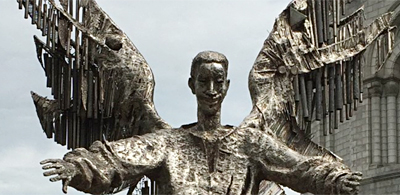Not NOW Shahzia Sikander!
On Jan. 14, 2023 a golden bronze statue of a “femalefigure” was installed on the rooftop of the Appellate Division Courthouse of New York State.
Created by 53-year-old Pakistani-American artist Shahzia Sikander and titled NOW, it’s a tribute to, but not a portrait of, the late Supreme Court Justice Ruth Bader Ginsburg and her “fight for abortion rights.” It’s also feminist agitprop against the nine statues of notable and historic male lawgivers that sit atop the courthouse.
NOW is an 8-foot-tall bronze statue with a gold patina that depicts a non-human entity with gigantic horns made of twisted braided hair growing out of its head—evocative of a satanic baphomet.
The figure rises out of a lotus blossom and instead of arms and feet it has a mass of tentacle-like appendages. On the upper body the tentacles branch out of the shoulders and loop down to re-enter the torso. The humanoid is stark naked, its breasts have no nipples, and like a 1950s Barbie Doll… it has no female genitalia.

To be fair Sikander has not described her statue as I have; the artist describes NOW with these words: “She is a fierce woman and a form of resistance in a space that has historically been dominated by patriarchal representation.” While that’s the politically correct jargon of the day, and the corporate press uncritically accepts Sikander’s explanation—perhaps a bit too ardently—large numbers of people still see something repulsive and demonic. As for the tentacles, the artist explains them thusly: “The self-rooted body represents the resilience of women, who can carry their roots wherever they go.” Sounds like she’s speaking of photosynthetic organisms, in other words… plants.

When I first viewed a photo of NOW I thought of the Martian leader from the 1953 science-fiction film Invaders From Mars—that extraterrestrial was a disembodied green head with tentacles instead of arms.
Yeah, what a great homage to Ruth Bader Ginsburg. Whatever one might think of RBG, I don’t see how this statue qualifies as a tribute.
If you spotted a creature like the one depicted in NOW, skittering towards you on “feet” of tentacles, you wouldn’t see a fierce woman but a monster… unless perhaps you were a member of the Satanic Temple.
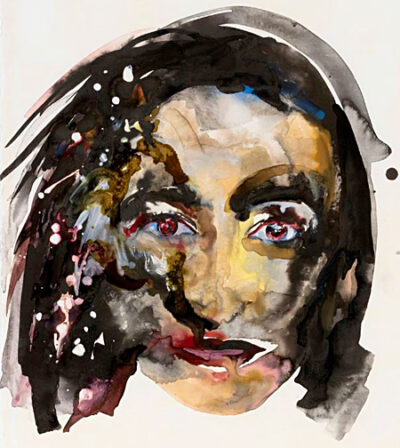
If you have any doubts about Sikander’s politics, or her artistic ability, check out her 2019 portrait of “Democratic Socialist” Alexandria Ocasio-Cortez.
Shahzia Sikander created her very first sculpture in 2020, a bronze she titled Promiscuous Intimacies. It depicts a Greco-Roman Venus intertwined in an amorous tryst with a female who is a forest spirit or village god of India known as “devata.”
She calls the statue a “non-heteronormative anti-monument.” It’s another one of her incoherent critiques of colonialism.
Her next statue was the 2023 NOW… hopefully it will be her last. Sikander is not known as a sculptor at all—drawing and miniature paintings are her forte.
A Muslim, Sikander grew up in Lahore, Pakistan, where she studied at the National College of Arts. She became interested in 16th century Indo-Persian miniature painting, a stylized art form given to bright colors, precise detail, religious themes, battle scenes, mystical experiences, and court life. Comparable to European illuminated manuscripts, Indo-Persian miniatures are usually a few inches in size; some painted with brushes made from a single hair. Sikander is hailed by some for appropriating the tradition, subverting and undermining it with feminist subject matter. She came to the US in 1993, and became a US citizen in 2015.
The Madison Square Park Conservancy commissioned Sikander to create three public art pieces; the result was NOW, Witness, and Reckoning. A duplicate of NOW, Witness differs only because the figure is suspended in a cage-like metal dress. The sculpture is located in Madison Square Park across the street from the Appellate Division Courthouse. On another patch of grass near Witness sits Reckoning, an animated audio-visual piece shown twice daily on a screen. Nonetheless, this review is about NOW.
NOW, Witness, and Reckoning are thankfully not permanent installations. Come June 2023 NOW will be taken down and sent to Houston, Texas for display. Lord knows what the good people of the Lone Star State will think of it.

As an artist I realize that viewing an artwork is a purely subjective experience, based entirely upon a given individual’s feelings and perceptions; show an artwork to ten different people and you’ll get ten different opinions. No matter the artist’s intent, there is no wrong way to interpret an artwork. In NOW some see a “luminous allegorical female figure,” while others see a tentacled devilette. Suffice it to say, if immense numbers of people see your poetic allegory as demonism, you might want to rethink your artwork.
Which brings me to the subject of postmodern art being the wrecking ball of civilization; follow the disorder’s path. The unveiling of NOW was one day after the Jan. 13, 2023 unveiling of The Embrace, the headless bronze statue that is a jumble of hands, arms, and shoulders meant to represent Dr. Martin Luther King Jr. and his wife Coretta Scott King. I would be remiss not to mention Oracle, a giant bronze statue placed outside Rockefeller Center in May of 2021; it fused a huge African mask to a diminutive Greco-Roman figure. Then there’s Vessel, the sixteen-stories high climbable statue that was dedicated in March of 2019; it became a suicide platform where people jumped to their deaths before the building was closed… perhaps permanently.
In statements made to the press, Sikander said her statue is called NOW “because it was needed ‘now,’ at a time when the women’s reproductive rights were under siege after the US Supreme Court in June overturned the constitutional right to abortion.” She went on to acknowledge that the title of the sculpture was also a nod to the National Organization for Women (NOW). I don’t wish to make enemies, but Ruth Bader Ginsburg was a frequent critic of Roe v. Wade. She believed gradualism in state legislatures and courts would secure the right to reproductive freedom, and thought Roe “a faulty decision.”
Legalities aside, there is nothing about Sikander’s sculpture that hints at the legacy of Justice Ginsburg. Around the neck of the grotesque bronze statue the artist rendered a jabot, indicative of the decorative lacy collars Ginsburg wore with her traditional black Judicial robe. Using Sikander’s logic, one could take a bronze statue of the Frankenstein monster, place a collar of lace around its neck, and call it a tribute to Ruth Bader Ginsburg. Of course no one would take such an absurdity seriously—so why is praise lavished upon Sikander’s monument?

Because postmodern art is so worthy of mockery, I make light of Sikander’s contention that NOW is a depiction of women and femininity. But there is a seriousness to my critique. In the above mentioned statement Sikander said: “The feminine is at the center of the two sculptures, NOW and Witness.”
Elsewhere she has said: “Aspects that are critical for me are basically how society perceives the idea of femininity in conversation with power, and how these social forces shape women’s lives.”
However, in today’s society we are living in a period where the very idea of “woman” is being erased.
Let’s not forget that during her Supreme Court confirmation hearings in March, 2022, Biden appointee Judge Ketanji Brown Jackson was asked by Senator Marsha Blackburn: “Can you provide a definition for the word woman?” Jackson’s reply: “I can’t… I’m not a biologist.” Where is Sikander’s screed on how “these social forces shape women’s lives”? Sikander only muddies the water with her tentacled gynosphinx.
Speaking in one voice the corporate press lauded Sikander’s NOW as the “first woman” or “first female” figure to be displayed at the Appellate Division Courthouse. The New York Times wrote the following headline: “Move Over Moses and Zoroaster: Manhattan Has a New Female Lawgiver.” Not to be outdone, the Art Newspaper headline was: “It was screaming for a female: Shahzia Sikander on creating a statue of a woman for a Manhattan courthouse.”
The TimeOut website offered the ridiculous headline: “For the first time, a statue of a woman sits atop this Manhattan courthouse.” The subhead was no less fatuous: “At last, this work puts a female figure on a level plane with the traditional, patriarchal depictions of justice and power.”
Those headlines are all lies. Of the 9 marble sculptures that sit atop the Appellate Division Courthouse, the pinnacle figure is none other than Lady Justice, the female personification of jurisprudence. She reigns supreme over all the other statues on the courthouse, and is based on the ancient Roman goddess of Justitia, who held a sword and scale. Long before she was placed on the courthouse, Lady Justice had become the quintessential symbol of justice in the Western world; she is usually depicted with a sword symbolizing swift justice and scales representing the careful weighing of evidence.
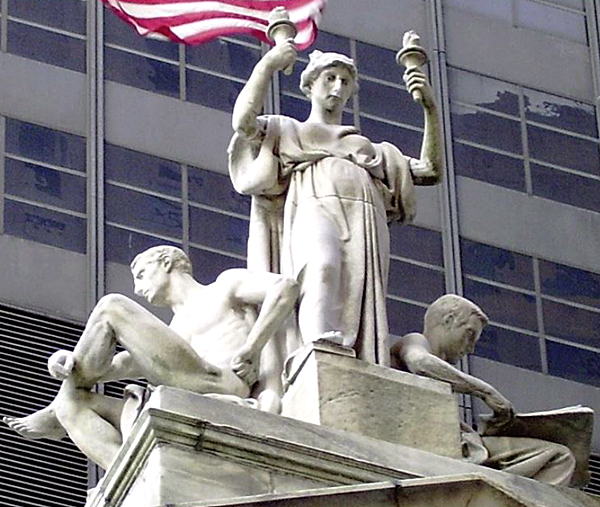
In 1900 American sculptor Daniel Chester French (1850-1931), created the white marble statue of Lady Justice that adorns the pediment of the courthouse; he titled it Justice. The sculptor had already created one of America’s most famous bronze statues in 1874, The Minute Man located in Concord, Massachusetts. In 1920 he would create the monumental white marble statue of Abraham Lincoln for the Lincoln Memorial in Washington, D.C. French was an exceptional artist of prodigious talent; no matter how much the press may beslobber and overflatter Shahzia Sikander, she’ll never be in the pantheon with Daniel Chester French.
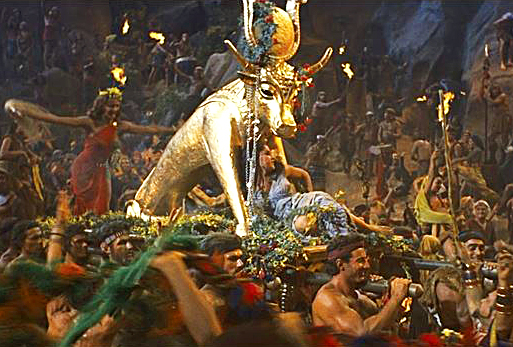
Tentacled extraterrestrial aside, who on earth thought erecting a golden statue on the roof of a US courthouse was a good idea? A courthouse is a place where impartial justice is handed out evenly to rich and poor… or so I’ve been told. I can understand a sculpture of Lady Justice being associated with a courthouse, but a statue of gold? Really? I am far from being a practicing Christian, but doesn’t anyone remember the biblical story of the Golden Calf, where God punished the people for breaking the Ten Commandments because of their idol worship?
It is not surprising to learn that in 2017 Sikander served on New York City’s Mayoral Advisory Commission of City Art, Monuments and Markers, a censorious group set up by liberal Democrat Mayor de Blasio (2014-21), seemingly for the purpose of finishing what Antifa and Black Lives Matter had started, namely, the removal and or destruction of statues deemed politically incorrect.
The Commission told de Blasio what “controversial monuments” needed to removed, relocated, and or given “informational plaques” that explain the “problematic” history of a statue deemed offensive. One of the statues targeted was the Theodore Roosevelt Memorial statue that sat outside the American Museum of Natural History in Manhattan for over 80 years. On Jan. 19, 2022 a crane took down the bronze memorial. One has to wonder what role Sikander played in dismantling that piece of American history. It’s poetic justice that large numbers of Americans would like to see Sikander’s NOW removed, or at least saddled with an explanatory plaque.
It’s ironic that the Roosevelt Memorial will be relocated to North Dakota, where it will become part of the Theodore Roosevelt Presidential Library in 2026. The chief executive officer of the Library Foundation, Edward O’Keefe, made a wry statement about the transfer: “Museums are supposed to do hard things. It is said that ‘those who do not learn from history are doomed to repeat it,’ and our job is to forthrightly examine history to understand the present and make a better future.” Now why didn’t NYC’s American Museum of Natural History say that and keep the statue?
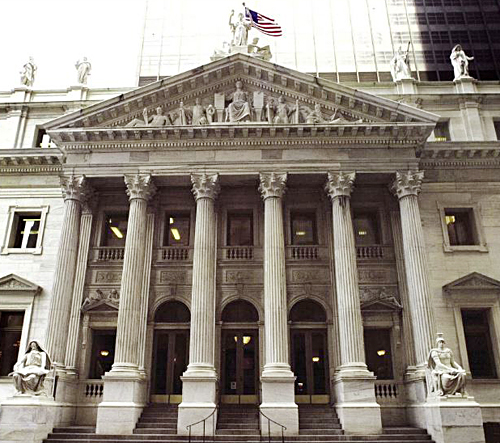
Sikander’s NOW is an affront in so many ways. As an artwork it’s an eyesore that is utterly out of place sitting atop the Appellate Division Courthouse. Designed by American architect James Brown Lord, the exquisite marble-faced, three-stories high building was inspired by the City Beautiful Movement and constructed in the Beaux-Arts architectural style between the years 1896 and 1899. Sorry, putting the mawkish NOW on the roof is akin to erecting a billboard there for the latest Marvel comic book film.
The influential reform oriented City Beautiful Movement was a school of American architecture motivated by the idea of bringing beautification, stateliness, and grandeur by way of monumental architecture, to cities suffering from dilapidated buildings and the squalor of run down tenements. It also advocated the creation of urban parks and tree-lined boulevards. The Appellate Division Courthouse is thought to be one of the best examples of the City Beautiful Movement style of American architecture from the 1890s.
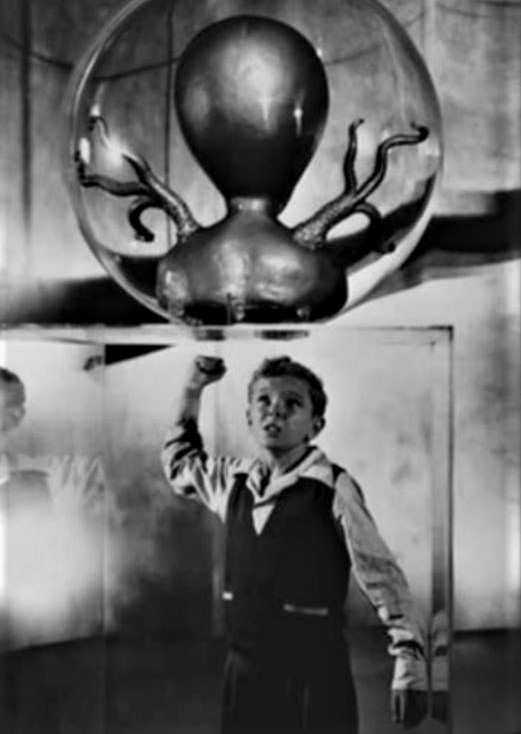
For the sculptural decorations and figures that were part of his Beaux-Arts masterwork, James Brown Lord chose from among the most talented sculptors of the day—all giants in their field; one crew worked on interior sculptures and another created exterior sculptural works.
Altogether sixteen sculptors worked on the courthouse, and all of them belonged to the National Sculpture Society, which was founded in 1893 to promote the welfare of American sculptors.
There once were ten white marble sculptures situated on the courthouse roof ledge, and ten different sculptors worked on creating them. The statues were of justice givers and legal thinkers like Confucius, Moses, Zoroaster, King Alfred the Great, Saint Louis, Manu, Lycurgus, Solon, Justinian, and yes… the Islamic prophet Mohammad.
Edward Clarke Potter, who in 1911 sculpted the famous pair of Lions found at the entrance of the New York Public Library, carved the statue of Zoroaster. Henry Kirke Bush-Brown sculpted the marble sculpture of Byzantine emperor Justinian. All of the marble statues on the rooftop were damaged over time by pollution, in 1953 the statues were cleaned and repaired; only then was the forgotten Muhammad figure “rediscovered.”
It’s intriguing that James Brown Lord and his associates found interest in Islam’s contributions to American law, and so chose Muhammad as one of the rooftop lawgivers; a gesture made out of respect. Sculptor Charles Albert Lopez sculpted the figure dressed in robes and a turban, with a long beard and clutching a sheathed curved scimitar sword.
After the cleaning in ’53 the Islamic governments of Pakistan, Egypt, and Indonesia found out about the statue, and demanded that it be removed since Islamic law prohibits human portraiture, especially portraits of Muhammad. In 1955 the marble figure of Muhammad was not only taken down, it was apparently destroyed… and then there were nine. Good luck finding a photograph of the statue, if a photo of it exists no one will publish it out of fear of retribution.
Facing the entrance of the courthouse, the Muhammad statue would have been seen on the rooftop at its westernmost corner. Of course the removal of the Mohammad figure in ’55 left an open space in the lineup of statues placed along the rooftop. The remedy was simple; the statues that had stood left of Mohammad were each moved over one place, that left an empty pedestal on the easternmost corner of the building. Things remained like this for almost seventy years… that is until Shahzia Sikander arrived.
That’s another great irony in this tale. Sikander, the Muslim Pakistani-American artist, was able to leave a decidedly un-Islamic statue on the easternmost corner pedestal, because the statue of Mohammad had been removed and destroyed.
In an Artists Statement uploaded on the Madison Square Park Conservancy website, Sikander said: “I have always had an affinity for the anti-monument in my practice.” She certainly achieved her goal with NOW. In that same statement the artist noted that her “artistic process” starts as “engagement with community, and careful listening.”
Well, I hope she’s listening very carefully.




